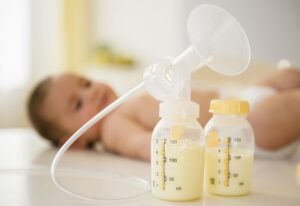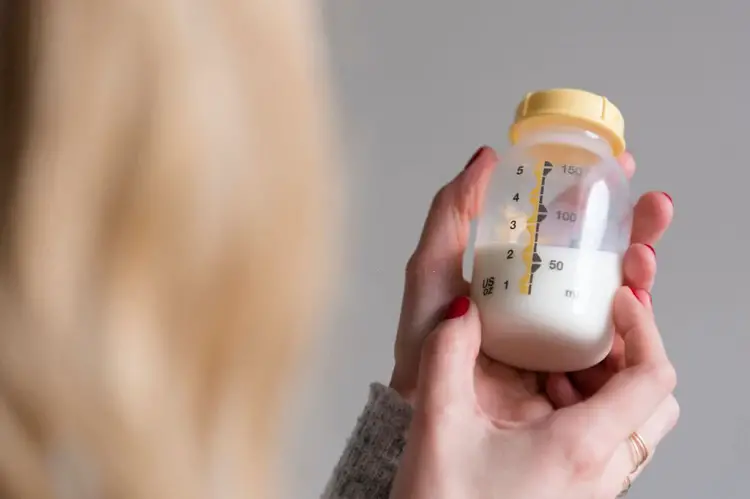Do you think that your pumped breast milk looks thin or perhaps watery? Have you asked yourself why is my breast milk so watery? after seeing that your breast milk looks thin?
When pumped, breast milk separates into a fatty layer on top and a watery layer on the bottom when put in the fridge.
This is a normal thing! This article discusses everything you need to know about watery breast milk.
Breast Milk: All You Need To Know
Breast milk is the fluid produced by the mammary gland in female vertebrates.
It is produced by the mammary glands, stored in the breast, and flows through the nipples, especially when sensitized by your baby or by gentle touch.
In the vertebrate phylum, breast possession helps differentiate males from females. Breast development is one of the unique signs in females during puberty.
A Pregnant woman undergoes some noticeable physical changes and signs in her body.
These signs include swelling of the feet, enlargement of the uterus causing the bulging of the stomach, and formation of breast milk which is achieved by the hormone oxytocin.
The hormone prolactin is in charge of the flow of breast milk and sometimes needs to be stimulated by the sucking activity of the baby on the mother’s nipple to trigger its flow.
Most moms are worried that their breast milk doesn’t flow. This is usually a source of concern because of how big the breast milk laden in the breast is and how it causes general discomfort.
Read: How To Get Your Milk To Refill Faster
Breastfeeding: All You Need To Know
Breastfeeding, or nursing, is ta term used to define feeding a child, particularly a baby, with human breast milk.
When feeding your child with breast milk, it could be done directly from the milk or even pumped and then given to the child much later, especially if the mother undertaking exclusive breastfeeding is a working mother.
World Health Organization (WHO) recommends that breastfeeding begin within the first hour of a baby’s life and continue as often and as much as the baby wants.
On exclusive breastfeeding, health organizations, including WHO, take or stand that a baby should be fed with breast milk exclusively for six months.
This simply means that the baby feeds on no other food or drink than vitamin D and breast milk.
Why Is My Breast Milk So Watery?

Watery isn’t a sign of a medical condition or ill health. It is a natural phenomenon that is perfectly okay.
Watery breast milk is referred to as foremilk, the first milk that flows at the beginning of a pumping session.
This milk is thinner and has lower fat content when compared to the otherwise creamier, whiter milk that comes at the end of the pumping session.
This happens biologically; while the milk is being produced, fat adheres to the sides of the milk-making cells, and while this happens, the watery part of the milk moves down the ducts to your nipples.
At the nipple, this watery part meets leftover milk from the last feeding session and then mixes with it to produce breast milk that looks watery or the foremilk.
The more prolonged the intervals between feeding sessions, the more diluted breast milk tends to be, but if the intervals are negligible, both sessions occur close together, and you may not have watery breast milk.
This watery breast milk or foremilk has a smaller lactose content than the milk stored in the milk-making cells, and the milk in the milk-making cells comes out after the foremilk has been produced.
This last set of milk that seems creamier and thicker is called hindmilk.
Why is My Stored Breast Milk Watery?
Milk falls under the class of liquids known as an emulsion. The composition of milk is a mixture of various things suspended in water.
The fat content of milk is about 5%, and that fat is dispersed through the water as tiny globules and little proteins surround the fat.
When milk is frozen or allowed to sit on the counter, the fat content of the milk will rise to the top, and the portion of the milk that houses more of the water content, lactose, proteins, and water-soluble vitamin will then settle on the bottom and will become translucent.
When you want to feed your baby and notice that the above phenomenon has occurred, don’t be scared, and don’t try shaking the bottle to homogenize.
Instead, you swirl gently on a table and begin your feeding session. There is no need to panic.
Read: Breast Milk Smells Like Vinegar (Explained)
What Happens If Baby Drinks Too Much Watery Milk
A baby may develop lactose overload, or foremilk/hindmilk imbalance, if they consume too much watery foremilk and not enough hindmilk over time.
It occurs when the fat content of their feedings becomes out of balance, and they have difficulty digesting all the lactose in the foremilk.
This may happen if your baby switches sides too frequently before finishing one breast or spaces out feedings too long or if you have an oversupply of breast milk.
Symptoms of lactose overload:
- Gassiness
- Green (foamy) stools
- Milk digestion issues
How To Ensure Baby Gets Enough Of The Foremilk And Hindmilk
- Feed your baby on demand and let your baby decide how long the feed will last
- Allow your baby to feed on each breast until his satisfied
- Always empty your breasts
So far, your baby is breastfeeding effectively; the baby is likely getting the perfect mix of foremilk and hindmilk.
You can also increase the amount of hindmilk your baby gets at each feeding by incorporating breast massage and this handy little tool.
Read: Why Do My Breasts Leak When Baby Cries? Explained
What Determines How Much Fat is in Your Breast Milk?
One of the main factors determining breast milk fat content is how empty the breast is.
The more empty the breast is, the fattier the milk becomes, and vice versa.
Thus, milk expressed at the beginning of a nursing or pumping session tends to be waterier than milk expressed at the end.
In some cases, this may not be true if the sessions occur close together – and the breast doesn’t have time to refill.
The milk expressed at the beginning of a nursing or pumping session is called foremilk, while the milk expressed at the end is called hindmilk.
Are Foremilk And Hindmilk Different Kinds Of Milk?
No. Due to how milk is stored in the breast, the fat content of breast milk changes with each nursing or pumping session.
The fat globules in milk stick together, and the alveoli, as your breasts, produce milk. During the expression process, the less sticky parts of the milk (the watery, less fatty parts) flow out first.
Fat globules dislodge and flow out of the milk as the feeding or pumping sessions continue, resulting in fatter and fatter milk.
Should I Still Breastfeed My Baby with Watery Milk?
There is no need to be skeptical about giving your baby watery breast milk; it won’t cause any problems for your baby.
When the breast milk seems watery at the beginning of the feeding session, continue with it as your baby will still drink the hindmilk before the end.
So there is nothing bad about giving your baby watery milk unless your breast milk never gets thick before the feeding session.
Can The Food I Eat Help Make My Breast Milk Fattier?
Studies have shown that what you eat while breastfeeding has little or no effect on the amount of fat or calories in your breast milk – women in famine conditions produce milk that provides optimal nutrition for their babies.
However, what you eat during breastfeeding may affect the types of fat, taste, or look in your milk.
Related Posts:
- Foods That Make Breast Milk Taste Good
- Why Your Breast Milk Smells Like Eggs
- How Much Milk To Pump For Daycare? Explained
- Why Your Breast Milk Taste Salty
Wind Up
Hopefully, this article has provided in-depth knowledge to answer the question of “why is my breast milk so watery?”
It is not a medical condition, so there is no need to panic or become frightened that you are producing your foremilk.
Also, when the breast milk seems watery at the beginning of the feeding session, continue with it as your baby will still drink the hindmilk before the feeding session.
So there is nothing bad about giving your baby watery milk unless your breast milk never gets thick before the feeding session.
